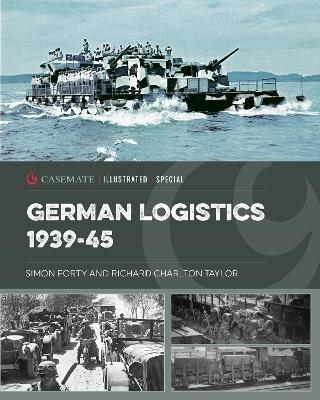
German Logistics 1939-45
Casemate Publishers (Verlag)
978-1-63624-518-8 (ISBN)
- Noch nicht erschienen (ca. Oktober 2025)
- Versandkostenfrei innerhalb Deutschlands
- Auch auf Rechnung
- Verfügbarkeit in der Filiale vor Ort prüfen
- Artikel merken
When we think of the German Army we think of the Blitzkrieg years, 1939–41, during which Panzers pushed deep into enemy territory and forced huge encirclement battles that annihilated the enemy’s strength in Poland, France, the Balkans and the Soviet Union. With their Auftragstaktik and cutting-edge weaponry, they epitomised incisive modern war.
However, there was an elephant in the room, and in spite of their superb battlefield leadership, their brilliant victories, their technical prowess, their mighty Tigers and Panthers, they lost because of it.
It wasn’t, as the German generals argued postwar, the Soviet hordes that swamped them. It wasn’t the industrial capabilities of the United States. It wasn’t the control exerted by a dictator increasingly removed from the real world. It wasn’t the amount of effort spent transporting millions of people to their deaths in the camps, or the amount of concrete poured into the Atlantic Wall from the Arctic to the Mediterranean.
All these points helped swing the war in the Allies’ favour but they weren’t the main reason why the German Wehrmacht lost. The elephant in the room was logistics.
It’s easy to point out how well the Germans achieved their Blitzkrieg successes, but the war didn’t end in 1941. It’s easy to talk about the positives of German logistics—the fact that they could advance so far into the Soviet Union over such difficult terrain until the weather and poor roads conspired against them; the way that German industry kept going in spite of Allied strategic bombing; the resilience and resourcefulness of the way they kept the railways running, allowing huge numbers of men and armoured vehicles to shuttle from east to west as they were needed.
In the end, at the critical moments in the war, their logistics failed them
Simon Forty was educated in Dorset and the north of England before reading history at London University’s School of Slavonic and East European Studies. He has been involved in publishing since the mid-1970s, first as editor and latterly as author. Son of author and RAC Tank Museum curator George Forty, he has continued in the family tradition writing mainly on historical and military subjects including books on the Napoleonic Wars and the two world wars. Recently he has produced a range of highly illustrated books on the Normandy battlefields, the Atlantic Wall and the liberation of the Low Countries with co-author Leo Marriott. Richard Charlton Taylor has been schoolteacher, light infantryman and businessman. A collector and trader in World War II militaria, he has worked with Simon Forty on several projects sourcing images and providing detailed military knowledge of weapons, equipment, and tactics.
INTRODUCTION
Definitions, quick survey of German WWI logistics and the prewar plans.
1 Strategic logistics
Logistical activities that are conducted at national and international levels.
• Industry, politics and the Nazis
• The supply chain
• Oil
• Manpower
• Auxiliary troops: NSKK (Nazionalsozialistisches Kraftfahrkorps); RAD (Reichsarbeitdienst); OT (Organisation Todt)
• Shipping operations
• The evacuations of 1945
2 Operational logistics
Activities within the theatre of operations: reception, storage, and distribution of supplies and personnel; dealing with casualties; maintenance and repair of equipment; transportation systems. The Grosstransportraum between railheads and fighting troops. Logistics during attack and retreat.
• Roads and raputitsa
• Bridging
• Mechanisation
• Horses
• Railways
• Air supply
3 Tactical logistics
Activities of units engaged in combat: supplying troops in the field.
• Food and fodder
• Ammunition
• Fuel
• Wandering pockets
• Festungen
Summary
Today, the US armed forces have seven principles when it comes to logistics:
1. Responsiveness: Providing the required support when and where it is needed.
2. Simplicity: fosters unity and efficiency in planning and execution, and reduces the fog of war and the friction caused by combat.
3. Flexibility: the ability to improvise and adapt to changing situations and requirements.
4. Economy: using the minimum amount of resources required to bring about an objective.
5. Attainability: the point at which sufficient supplies, support and distribution capabilities exist to initiate operations at an acceptable level of risk.
6. Sustainability: the ability to maintain the necessary level and duration of logistics support to achieve objectives.
| Erscheint lt. Verlag | 1.10.2025 |
|---|---|
| Zusatzinfo | 250 |
| Sprache | englisch |
| Maße | 203 x 254 mm |
| Themenwelt | Geschichte ► Allgemeine Geschichte ► 1918 bis 1945 |
| Geschichte ► Teilgebiete der Geschichte ► Militärgeschichte | |
| Sozialwissenschaften ► Politik / Verwaltung | |
| ISBN-10 | 1-63624-518-8 / 1636245188 |
| ISBN-13 | 978-1-63624-518-8 / 9781636245188 |
| Zustand | Neuware |
| Haben Sie eine Frage zum Produkt? |
aus dem Bereich


